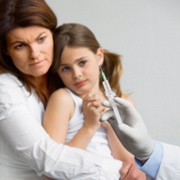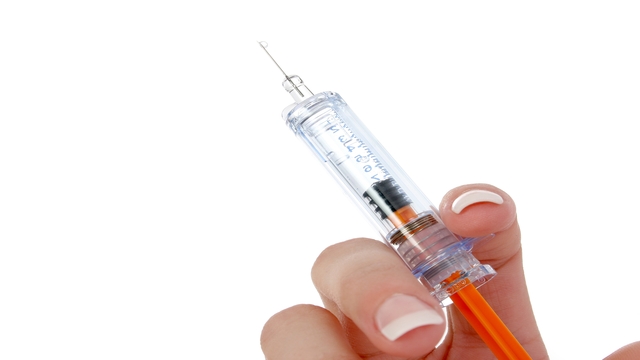 Photo: Getty Images
Photo: Getty Images
A recent whooping cough epidemic in California has affected 4,223 people and sadly resulted in the deaths of nine young babies. But while some pediatricians are keen to blame parents who don’t vaccinate, the issue is far more complicated than that.
The California epidemic is not the first time a whooping cough epidemic has occurred in recent years and the problem of vaccine waning has been discussed in medical journals for decades.
Vaccine Waning
Vaccinations don’t last for a lifetime. In fact, the duration of the whooping cough vaccine is thought to be only about five years. A Polish study found that only 45 percent of vaccinated eight year olds still had any detectable antibodies to pertussis: "Protective antibody levels were detected in 70%, 58%, and 45% children aged 6, 7, and 8, respectively. It shows that decrease of immunity may cause increasing number of pertussis in children above 5."
This study and others like it led to the introduction of a pre-school booster dose of the vaccine. Given its limited time span, even the booster will have worn off by the time the child is 10 or 12. This is why large numbers of cases are now occurring in previously vaccinated teenagers and parents. They can then spread the infection to newborn babies. Babies aren’t considered immune to whooping cough until they have had three or four doses of vaccine (depending on what country you’re from and what schedule you’re working to). The third dose is given at six months old. The higher danger period is in the first six months of life with the majority of deaths occurring before then, so in fact even if a parent has chosen to vaccinate, which most do, their baby isn’t considered immunized in that riskier period.
Vaccinating Older People
To counter this problem, medical policy makers have begun to advise that new parents be vaccinated with DtaP to protect their babies, in addition to introducing more boosters for teenagers. This is a new policy with the theory of minimizing an infant's exposure to pertussis by vaccinating those around him. However, the makers of one such vaccine, Adacel, say they don’t know if this approach will work: "It is unknown whether immunizing adolescents and adults against pertussis will reduce the risk of transmission to infants."
Vaccine Failure
Another issue is those people who have had all the recommended boosters of vaccine and still get whooping cough. Many people affected in epidemics are already fully vaccinated. For instance, the Star Ledger Newspaper reported on February 11, 2009 that in an epidemic of 21 cases of whooping cough, all had been vaccinated. Another cluster of cases at an Elementary school in which 18 young people got whooping cough, 17 of them had had the five recommended doses of vaccine. In a similar outbreak in England, reported in the British Medical Journal, 85.9 percent of the sufferers had been fully vaccinated with all the recommended injections: "64 children had serological evidence of a recent Bordetella pertussis infection; 55 of these children had been fully immunised. At presentation, children with whooping cough were more likely than others to have whooping, vomiting, and sputum production. Children with whooping cough were also more likely to still be coughing two months after the start of their illness continue to have more than five coughing episodes a day and cause sleep disturbance for their parents.
"Conclusions: For school age children presenting to primary care with a cough lasting two weeks or more, a diagnosis of whooping cough should be considered even if the child has been immunized. Making a secure diagnosis of whooping cough may prevent inappropriate investigations and treatment."
Dr. Kari Simonsen, a pediatrician from University of Nebraska Medical Center, said that the vaccine doesn’t work for one in five people vaccinated and that one in five people who have had the shot still go on to develop whooping cough.
“The efficacy of the vaccine is comparatively low”, she said, “but it’s the best vaccine we can build to date.”
Sub-Clinical Infection
In addition to not working, or waning, the vaccination has changed the clinical presentation of the illness, adding to the risk of transmission. In full whooping cough with its range of symptoms, parents would know to keep their children away from other children and to seek prompt treatment, but vaccinated children can have whooping cough without the symptoms and be capable of spreading it to newborn babies without even knowing it.
A study in Israel, mentioned in a CDC document, found that vaccinated people were "silent reservoirs for infection":
"Vaccinated adolescents and adults may serve as reservoirs for silent infection and become potential transmitters to unprotected infants. The whole-cell vaccine for pertussis is protective only against clinical disease, not against infection. Therefore, even young, recently vaccinated children may serve as reservoirs and potential transmitters of infection."
Although they referred to the whole cell vaccine, the new acellular version is known to be less effective.
A New Type of Whooping Cough
Another reason for epidemics is the fact that pertussis has mutated into another form of the illness, just like bacteria evolve to combat antibiotics and lice become resistant to insecticide head lotions. The Journal of Microbiology reported that a new, stronger, resistant type of pertussis was developing in a highly vaccinated population.
The Journal Vaccine also reported a new form of pertussis:
"Bordetella pertussis isolates not expressing Pertussis Toxin (PT) or Pertactin (PRN) have been collected, for the first time in 2007, in France, a highly vaccinated country with acellular vaccines."
So the problem of pertussis in very young infants is clearly much more complex than whether or not we have all had our boosters.
1. Sources: Slusarczyk J, Dulny G, Nowak K, Krszyna J, Wysokinska T, Fordymacka A, Gzyl A, Janaszek W, Gniadek G: Immunity of children aged 6–8 against pertussis, tetanus and diphtheria. Przegl Epidemiol 2002 , 56:39-48
2. VaccinePlace.com - http://www.adacel-locator.com/index.cfm?FA=protect/adacel/content&S=HOME&P=HowS_pread
3. The Star Ledger, 11th February 2009.
4. The Atlanta Journal Constitution, 22nd March 2009.
5. http://www.bmj.com/content/333/7560/174.abstract
6. http://www.cdc.gov/ncidod/eid/vol6no5/pdf/srugo.pdf
7. Journal of Clinical Microbiology, March 2009, p. 680-688, Vol. 47, No. 3
8. Vaccine, Volume 27, Issue 43, 9 October 2009, Pages 6034-6041.
Joanna is a freelance health writer for The Mother magazine and Suite 101 with a column on infertility, http://infertility.suite101.com/. She is author of the book, 'Breast Milk: A Natural Immunisation,' and co-author of an educational resource on disabled parenting, in addition to running a charity for people damaged by vaccines or medical mistakes. Her 13 year old daughter, Jerrica, had whooping cough when she was a baby.




Add a Comment9 Comments
Whooping cough provides immunity which is much more robust than the temporary one given by vaccines. In previous generations most children had it in early childhood (2+ years) and would be immune later on through natural immunity and frequent re-exposure to others in the community who had it. Mothers had had it as children so they provided placental and breast milk antibodies to it so babies who were newborn did not used to get it - that wasn't the usual age for acquiring whooping cough. It has come about because mothers did not get natural immunity and cannot pass it on in pregnancy or through feeding. Also, as many babies are now formula fed this just increases the risk. Also even if you have the jab, you may be asymptomatic but you can still pass it on. See medscape article:
The effects of whole-cell pertussis vaccine wane after 5 to 10 years, and infection in a vaccinated person causes nonspecific symptoms[3-7]. Vaccinated adolescents and adults may serve as reservoirs for silent infection and become potential transmitters to unprotected infants[3-11]. The whole-cell vaccine for pertussis is protective only against clinical disease, not against infection[15-17]. Therefore, even young, recently vaccinated children may serve as reservoirs and potential transmitters of infection.'
http://www.medscape.com/viewarticle/414768_3
Of course we use DTaP now but as that is half-cell it has problems with duration of immunity anyway.
Terribly sorry for the problems your baby had but it can happen in unvaccinated and vaccinated alike and the vaccines don't prevent transmission, only symptoms.
Joanna (whose 2nd daughter also had whooping cough and whose friend's vaccinated son had it age 7).
January 25, 2012 - 5:34amThis Comment
In 1980, my beautiful 5-month old baby daughter nearly died from a DPT/polio "booster." Her soft spot, or fontanel, swelled in a condition called encephalopathy. We later read that 77% of babies with this reaction either died or were permanently brain-damaged. My baby survived with no other treatment than breastfeeding, which I continued until she was 2 1/2. The US currently lists infant deaths from vaccines as SIDS, but a check of infant mortality rates worldwide reveals that the US ranks 45th in infant mortality. We believe that this is caused directly by vaccines. They are neither "safe" nor " effective." If they were effective, why would everyone need a booster? I personally had all of the childhood diseases except polio, which isn't even a disease but a chemical fertilizer/insecticide poisoning. I remember that measles and chicken pox were itchy, and I remember the swollen feeling of mumps. All five of the children in my family had mumps at the same time, and I remember how we got to stay home and eat chocolate mint ice cream (non-GMO with real sugar, no high fructose corn syrup). My parents took pictures of us in party hats, and we were all smiling! Childhood diseases are actually good for the immune system, with no boosters required. They are very mild, nothing compared to the week of hell we endured in 1980 when my daughter nearly became a SIDS statistic and I lost 10 pounds from crying, nausea, and terror. That experience scared us away from vaccines and all "modern" medicine.9u9un
October 14, 2010 - 3:04amThis Comment
I'm sorry to here what happened to your daughter and am very glad she pulled through.
May I have permission to share your letter with others?
Thank you.
Joanna.
October 17, 2010 - 7:44amThis Comment
Actually, my new born twins contracted whooping cough from me (i caught it in hospital) at 37 weeks gestational age. They were only 3 weeks old at the time. They nearly died and one of them had a stroke due to the violent coughing. If I as a pregnant woman had been offered a pertussis booster as is the practise in several other countries (and perfectly safe during pregnancy!) this would not have happened. Reduced herd immunity and lack of booster vaccines in this country are responsible. Please stop spreading the myth that vaccination is a bad thing. A hundred years ago many many young children & babies died from whooping cough - it is a nasty, harrowing disease.
January 20, 2012 - 4:54pmSandrine Pickering
This Comment
As the article said you could have still been a carrier or not responded to the vaccine or the babies might not have responded. The amount of people who had bad reactions to the old pertussis vaccine even though it was still being given widespread for years had caused many to be hesitant since doctors did not acknowledge that there was a risk or when it occurred they still pressed for the vaccine.
For most the cdc recommendations are best but if you or your family knows that you might be one of those that is a higher risk for complications from vaccines caution is not unfounded. Giving more leeway too doctors to help parents that have a higher risk child instead of pulling the party line would engender more confidence and encouragemore vaccinate, even if at a slower pace.
November 9, 2014 - 8:58amThis Comment
Thank you for this bright comment in this article of ignorance and propaganda. Joanna needs to learn her science before she goes spreading lies and myths.
May 9, 2012 - 11:19amThis Comment
Never have they done studies of the cumulative effects of all vaccine ingredients and they keep adding more vaccines to the mix.
October 13, 2010 - 5:04pmHere is a list of ingredients that have been injected directly into the blood of babies, children and adults by passing the safety systems of the body. Keep in mind that this illustration is based on One Shot of each vaccine.
Toxic Vaccine Ingredients: Varicella virus/ human diploid lung cells, Embryonic Guinea pig cell cultures, Beef heart infusion/ fetal bovine serum, Ammonium Sulfate, Glutamate, Neomycin, Diphtheria, Tetanus Toxoids, & Acellular pertussis endotoxin, beef heart infusion/fetal bovine serum, aluminum, formaldehyde, Thimerosal (mercury derivative), phenol/phenoxyethanol, polysorbate 80 (Tween 80), dry natural latex --------------------------
Their is more:
http://www.squidoo.com/children-vaccinated-to-extreme
By the time the child is six years old the child will receive 36 shots with 109 vaccines. So what you are reading here may have been injected 36 times per each engredient. Do you think your DNA will ever be the same? Investigate befor eyou vaccinate - Please!
This Comment
Dr. Fritz Mooi' et al's research, which can be found at the CDC website by searching "pertussis mutation," supports Joanna's position. Here is one of their articles: http://www.cdc.gov/eid/content/15/8/1206.htm, F. Mooi et al, "Bordetella pertussis Strains with Increased Toxin Production Associated with Pertussis Resurgence," in "Emerging Infectious Diseases" 15(8), August 2009.
As one Korean researcher wrote, pertussis has not been a vaccine success story. In the US we still hear "Vaccinate! Vaccinate! Vaccinate!" Yet with vaccinated people being carriers that transmit the disease, the disease changing in response to vaccination, and immunity lasting only a few years, maybe it's time to take a step back and reconsider whether natural immunity was best in the long run. It is those who are too young to vaccinate, babies in the first two months of life, who are most at risk. Interestingly, we give the hepatitis B vaccine to newborns on the first day of life, when any vaccine will decrease general immunity for a time after being given. Perhaps we should reconsider this practice to best protect newborns from diseases such as pertussis.
JoAnn Faryon also supports Joanna's statements in her article, 9/7/10, "Is Whooping Cough Vaccine Working?" http://www.kpbs.org/news/2010/sep/07/whooping-cough-vaccine-working/
October 11, 2010 - 5:25pmThis Comment
I agree with Joanna. Vaccines are just a New World Order attempt to depopulate, along with circumcision, chemtrails, GMO foods and fluoride.
October 11, 2010 - 10:27amThis Comment